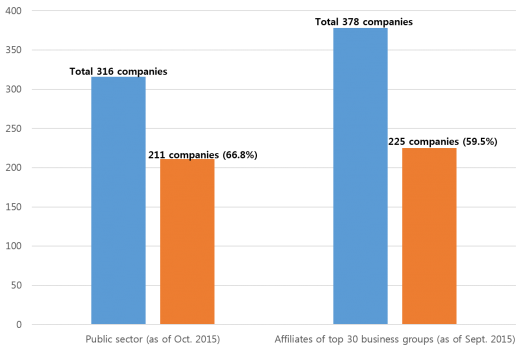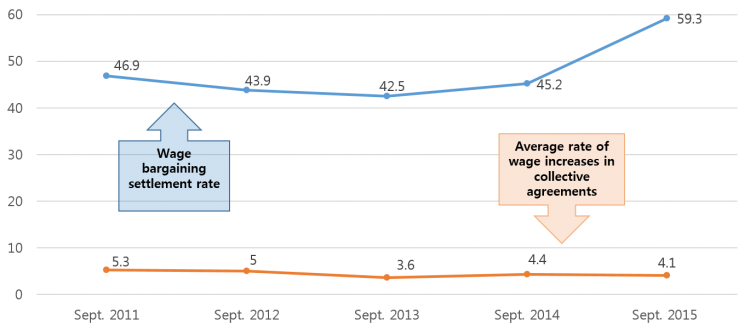1. Tripartite agreement on need for structural reforms of the labor market
Labor, management and the government reached an agreement on the principles and direction of structural reforms of the labor market in December 2014. Following this agreement, the Tripartite held 120 more meetings and reached a final Tripartite Agreement for labor market reform on 15 September this year. The Tripartite Agreement contains five goals and 65 actions for improvement of the labor market including promotion of youth employment; alleviation of the dual structure of the labor market; and expansion of the social safety net.
[Table 1] Tripartite Agreement on Structural Reform of the Labor Market
|
Items |
Major Details |
|
Youth |
▴ Use resources saved through adoption of a wage peak system to hire young workers
▴ Expand and improve the Employment Success Package targeting young people ▴ Establish a special consultative body for promotion of youth employment |
|
Dual structure of the labor market |
▴ Promote mutual prosperity based on win-win cooperation between primary contractors and subcontractors, and larger and smaller companies
▴ Improve laws and regulations regarding non-regular employment (the agreement is to be reflected into legislation by the National Assembly) ▴ Clarify the standards and procedures for termination of employment contracts |
|
Social safety net |
▴ Remove areas beyond the reach of social insurances and enhance their efficiency
▴ Increase coverage of unemployment benefits in terms of payment period and level of benefits ▴ Discuss ways to improve current method of determining minimum wage (no later than the end of May 2016) |
|
Three major labor issues |
▴ Clarify ordinary wage
▴ Modify laws and institutions to help reduce working hours ▴ Improve wage system to ensure a soft landing for extension of retirement age |
|
Tripartite partnership |
▴ Resolve unfair and unreasonable practices and establish a culture of productive bargaining |
Meanwhile, political parties continue to clash over labor reform bills. On 16 September, the ruling Saenuri Party took the initiative to push ahead legislation by submitting five labor reform bills to revise current labor laws, including the Labor Standards Act.
[ Table 2] Labor Reform Bills Proposed by the Ruling Saenuri Party
|
Related Acts |
Major Proposed Changes |
|
Labor Standards Act |
▴ Clarify the definition of ordinary wage
▴ Reduce working hours ▴ Modify the list of occupations excluded from the provision on statutory working hours |
|
Employment Insurance Act |
▴ Increase coverage of unemployment benefits
▴ Enhance efficiency |
|
Industrial Accident Compensation Insurance Act |
▴ Introduce compensation system for commuting accidents |
|
Act On The Protection, Etc. Of Fixed-Term And Part-Time |
▴ Restrict the use of fixed-term workers for core work involving life and safety
▴ Set limit on number of renewals for fixed-term contracts (max. three times within two years) |
|
Act On The Protection, Etc., Of Dispatched Workers |
▴ Permit those aged 55 or older to be used as dispatched workers for all jobs (except for firsthand production processes in manufacturing sector) |
However, the opposition parties argue that the bills proposed by the Sanuri Party go against the Tripartite Agreement on labor market reform. As they also call for so-called ‘chaebol reform’ along with labor reform, this labor-related legislation is expected to face difficult headwinds. In particular, as the National Assembly’s Environment & Labor Committee, in charge of deliberating on labor reform bills, consists of an equal number of lawmakers from the ruling and opposition parties with most lawmakers being pro-labor, there are concerns that the spirit of the Tripartite Agreement may be destroyed in the course of legislation.
2. Government focus on labor market reform
The government carried out policies focusing on job creation and improving the employment rate through labor market reform. As a result, the employment rate increased by 0.3% from the previous year (65.3%) to 65.6%.
The government is also focusing on creating jobs for youth by expanding the use of wage peak systems in workplaces, prior to extending retirement age to 60 in 2016. In particular, the government is aiming to change wage systems in the public sector systematically to job, capabilities, and performance, along with introduction of a wage peak system in all public institutions within 2015.
[Figure 2] Wage Peak Systems: Rate of Adoption

* Source: Ministry of Employment & Labor
Labor market reform will continue gradually in consideration of the general elections (April 2016) and presidential election (December 2017).
[Table 3] Plans for Labor Market Reform by Phase
|
Details |
|
|
Phase 1 (2015) |
Reduce labor market uncertainty and establish basic rules
‧ Handle bills related to labor market reform ‧ Distribute guidelines on procedures and criteria for amending rules of employment and terminating employment contracts ‧ Introduce wage peak systems at workplaces |
|
Phase 2 (April 2016) |
Reform industrial relations
‧ Improve minimum wage system, reduce types of industry exempted from statutory work hour limitations |
|
Phase 3 (December 2017) |
Establish new order in industrial relations
‧ Establish a new employment culture such as by promoting mutual prosperity for labor and management |
The government is also planning to promote industrial relations by issuing corrective orders to amend unfair articles in collective agreements and abolish unfair labor practices, etc.
3. Leadership in national union centers weakened, internal conflicts increase
During the process leading up to the Tripartite Agreement (concluded on 13 September 2015), the Federation of Korean Trade Unions (FKTU) had a serious internal conflict when some of its affiliates expressed their opposition to signing the Agreement. The FKTU first decided to oppose the government guidelines on modifying rules of employment and terminating employment contracts, and held a sit-in strike from 13 July to 29 August. However, the Federation held a central executive committee meeting on 26 August and decided to come back to the Tripartite Commission.
Even after the decision, three of the Federation’s affiliates (the Federation of Korean Metal Workers’ Trade Unions, the Federation of Korean Chemical Workers’ Unions, and the Federation of Korean Public Industry Trade Unions) announced their opposition to continuing discussions towards a tripartite agreement. Included in this opposition was an attempt by the three affiliates to physically hinder the FKTU from returning to the Commission.
The Korean Confederation of Trade Unions (KCTU) held general strikes, but intensity was weak as its affiliates did not actively participate. The Confederation held 3 general strikes on 24 April, 15 July, and 23 September to express their position against the government. However, the 16 industrial affiliates were only partially involved due to their own internal issues so the planned strikes became rallies.
* KCTU membership: around 650,000
* Number of members participating strikes: 34,000 members in the 1st strike, 9,500 in the 2nd strike, and 47,000 members in the 3rd strike
4. Disparities in industrial relations
As of September 2015, the wage bargaining settlement rate recorded 59.3%, representing a quicker pace than a year earlier (45.2%). A considerable number of companies carry out only wage bargaining this year, and it was found that companies having resolved major issues regarding ordinary wage and a wage peak system etc., settled early. As of end September 2015, the average wage increase rates in collective agreements recorded 4.1%, 0.3% less than a year ago.
[Figure 3] Wage Bargaining Settlement Rate & Average Rate of Wage Increases in Collective Agreements (Unit: %)
The minimum wage for 2016 was set at 6,030 KRW per hour, an increase of 8.1% over 2015. Minimum wage increases have remained fairly high.
[Table 4] Minimum Wage Trend
|
Year |
Minimum Wage |
Rate of Increase (YOY) |
|
2014 |
KRW 5,210 | 7.2% |
|
2015 |
KRW 5,580 |
7.1% |
| 2016 | KRW 6,030 |
8.1% |
The number of labor disputes remains quite similar to last year, while the number of work days lost decreased. However, year-end wage and collective bargaining with large companies such as Hyundai Motor, Hyundai Heavy Industries, and Kumho Tire has been prolonged, leading to the potential for lost work days to increase.
At the moment, some companies are working to establish a culture of cooperative labor-management relations. Lotte Group announced with all of its trade union leaders that the Group would continue working to form a ‘creative labor-management culture (21 May)’. The labor and management of SK Hynix decided to donate 20% (10% from labor, 10% from management) of the wage increase in 2015 for improving working conditions and occupational safety and health of the company’s subcontract workers (5 June) along with the wage agreement.
[Table 5] Labor Disputes & Work Days Lost (as of 21 Oct 2015)
| 1 Jan.~ 27 Oct. 2015 |
2014 |
|
|
Number of labor disputes |
93 |
94 |
|
Work days lost |
425,457 |
526,902 |
5. Unstable industrial relations in subcontractors of large enterprises
Labor strife within subcontractor companies of large enterprises such as SK Broadband and LG U+ increased as the Hope Union, an affiliate of the KCTU, focused on wage and collective bargaining issues within those subcontractors. One branch of the Hope Union (T-broad branch) demanded a large bonus for concluding a collective agreement, which led to another delay during bargaining.
Moreover, labor infringed on the autonomy of labor and management decision-making by inviting politicians (such as the Euljiro Committee under the New Politics Alliance for Democracy) to visit their worksites. The Korean Metal Workers’ Union, under the KCTU, continued labor action towards direct employment for non-regular subcontracted workers in the Union’s Kia Motors and Hyundai Motor branch.
The KCTU is expected to focus on organizing unions within workforces of subcontractors for large companies in wholesale and retail, and service industries in the future.
6. New labor issues arise
Labor and some politicians are making an issue of ‘emotional labor,’ which is used to describe the work-associated stress suffered by workers in the service sector.
Labor has organized an ‘Emotional Labor Network’ to increase social awareness of emotional labor issues in the service sector in general. Moreover, labor will demand additional bonuses or paid leave days for emotional labor during wage and collective bargaining, as well as organizing new unions in companies.
As the government and political parties are trying to legislate and revise laws related to emotional labor, more than 6 million workers (1/3 of the total wage workers) are expected to be covered by the laws.
A bill on protection of workers involved in emotional labor, a bill to revise the Industrial Accident Compensation Insurance Act and the Labor Standards Act are now pending in the Subcommittee for Legislative Review under the National Assembly’s Environment & Labor Committee. The government has already prepared a bill to revise the Occupational Safety & Health Act and is working on its legislation. The pre-announcement (2 November) of legislation of the revised enforcement decree and enforcement regulation of on Industrial Accident Compensation Insurance Act includes ‘adjustment disorder’ and ‘depression’ as occupational diseases.
[Table 6] Details in the Revised Bill of the Occupational Safety & Health Act by the Ministry of Employment & Labor
|
Article 24-2 (Prevention of stress at work) ② Employers who hire employees to provide face-to-face service to customers, patients, passengers etc., or to sell goods or provide services through spoken dialogue, shall take measures to prevent job-related stress, verbal abuse, violence, or harassment etc., from customers, in accordance with the Ordinance from the Ministry of Employment and Labor. |

